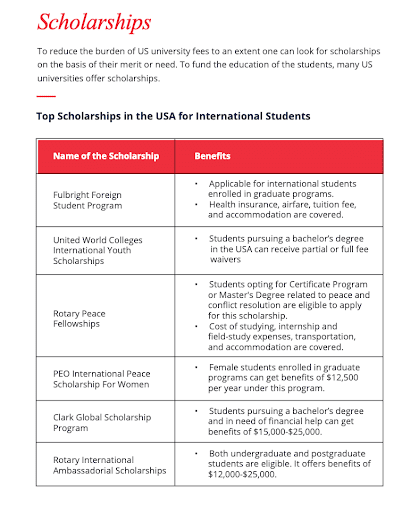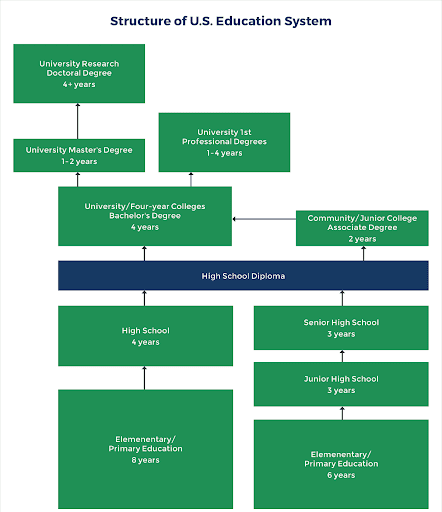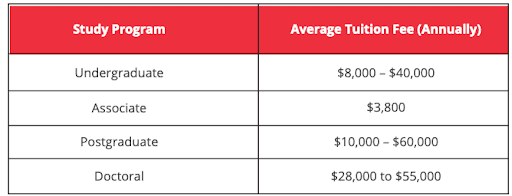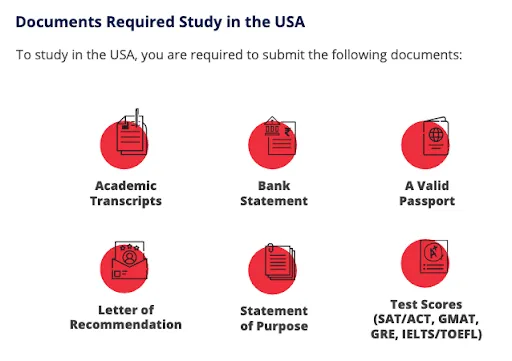Study Abroad in USA
Discover the easy steps required to study in USA with Scholars Zone as your trusted companion. We’re here to simplify the process for Bangladeshi students, from understanding admission requirements to finding the right institution, and right program and securing scholarships. Let us guide you through this exciting educational journey with ease. Start your application process today and take the first step toward your dreams of studying in USA.
Index
- Overview of the USA
- Facts & Figures
- Why study in the USA?
- Education System in the USA
- Top Courses in the USA
- Cost of Education in the USA
- Top Courses in the USA and Tuition Fees
Index
- Required Documents
- What is I-20?
- USA Application Process
- Scholarships
- FAQ
- Top Scholarships for Bangladeshi Students
- Visa Submission Guideline
Overview of Canada
Geographical Location:
The United States of America is the world’s third-largest country both in size and population, located in North America with the Atlantic Ocean to the east and the Pacific Ocean to the west. It shares borders with Canada to the north and Mexico to the south. With diverse geography, including forests, deserts, beaches, mountains, and water bodies, the U.S. consists of 50 states, a federal district (Washington, D.C.), five major territories, and various minor islands. Washington, D.C. is the nation’s capital, and each state and territory has its own capital city.
Language:
The predominant language spoken in the United States is English. Additionally, Spanish, Chinese, Vietnamese, French and Native American languages rank among the most commonly spoken non-English languages across the country.
Weather & Climate:
The United States has diverse weather, ranging from humid subtropical on the East Coast to Mediterranean on the West Coast. Central and northern regions face tornadoes and snowfall, while the southern states contend with hurricanes. Mountainous areas are colder, and extreme weather events can occur. Check local forecasts for accurate information.
Facts & Figures
- Population: Approximately 331 million (2021 estimate).
- Geography: Third-largest country, 3.8 million square miles, 50 states + Washington, D.C.
- Capital: Washington, D.C.
- Economy: Largest global economy, nominal GDP over $21 trillion (2021).
- Currency: United States Dollar (USD).
- Government: Federal presidential republic.
- Independence: Declared on July 4, 1776.
- Demographics: Diverse population, English as the primary language.
- Education: Home to prestigious universities and research institutions.
- Military: One of the world’s largest and most technologically advanced.
- Cultural Influence: Significant global influence in entertainment, music, and technology.
- National Parks: Rich in diverse landscapes, and numerous national parks.
Why study in the USA?
Abundance of Educational Options:
The USA offers an unparalleled variety and quality of programs and courses, providing students with a myriad of choices for their academic pursuits.
Ivy League Excellence:
Renowned for its Ivy League Universities, the USA serves as a hub for institutions that are globally recognized for their academic prestige and excellence.
Holistic Education Focus:
The American education system emphasizes holistic growth, fostering a well-rounded educational experience that includes skill enhancement.
Cultural and Ethnic Diversity:
The USA is a melting pot of cultures and ethnicities, offering students a unique and diverse environment as they interact with peers from around the world.
Extensive Support for International Students:
US schools provide comprehensive support for international students, including scholarships, housing assistance, academic resources, and opportunities to engage with various student groups.
Global Recognition:
Degrees earned from US colleges are globally recognized, enhancing the international reputation of graduates in the job market.
Job Opportunities and Internships:
Education programs in the USA often include work opportunities and internships, enabling students to gain valuable practical experience in their chosen field before graduation.
Affordable Domestic Travel:
With affordable domestic flights, students have the opportunity to explore various cities within the USA, enhancing their overall cultural experience.
Immersive American Culture:
Studying in the USA provides an opportunity to immerse oneself in the authentic American culture, both on and off-campus, fostering a rich and diverse cultural experience.
Choosing the USA for higher education ensures not only academic excellence but also a culturally enriching and globally recognized educational journey.
Education System in the USA
Top Courses in the USA
Types of Post-Secondary Institutions
Ivy League | State College or University | Community College | Institute of Technology |
Brown University | University of Michigan | Green River College | Illinois Institute of Technology |
Columbia University | University of California – Los Angeles (UCLA) | Miami Dade College | Massachusetts Institute of Technology (MIT) |
Cornell University | University of Virginia | Northern Virginia Community College | New York Institute of Technology |
Dartmouth University | University of California – Berkeley | Santa Monica College | |
Harvard University | |||
Princeton University | |||
The University of Pennsylvania | |||
Yale University |
Cost of Education in the USA
As there are close to 4,000 degree-granting institutions in the U.S., tuition varies among colleges. Generally, we advise students that the tuition for:
Community colleges: USD 10,000 – 12,000 a year.
Public Universities:
USD 18,000 – 40,000 a year
Private Universities:
USD 35,000 – 60,000 a year
Top Courses in the USA and Tuition Fees
Top Courses | Duration | Average Annual Tuition Fees |
BSc Nursing (BSN) | 4 years | $45,000/ year |
MBBS (BS+MD+Residency) | 8-10 years | $40,000/ year |
LLM | 1 year | $60,000/ year |
MA Applied Economics | 2 years | $35,000/ year |
MBA | 2 years | $70,000/ year |
MPH | 1 to 2 years | $50,000/ year |
MSc Computer Science | 1 to 2 years | $50,000/ year |
MSc Data Science | 1 to 2 years | $70,000/ year |
Required Documents
Admission Requirement
Programs | Admission Requirements |
Bachelors | Minimum GPA of 3.0 in SSC and HSC or equivalent along with an IELTS Score of 6.0 Many Programs require SAT or ACT scores. |
Masters | Minimum CGPA of 2.5 in Bachelor along with an IELTS Score of 6.0 Many programs require GRE or GMAT scores |
Ph.D. | Minimum CGPA of 3.0 in Masters along with an IELTS Score of 6.5 Most programs require GRE or GMAT scores Having a published journal or research paper would be a plus |
Typically, students applying to an undergraduate course need one of the below:
- TOEFL (internet-based test, iBT) scores between 60.0 and 100.0 overall
- IELTS scores between 6.0 and 7.5 with no band less than 6.0
Language requirements are stricter for some postgraduate and professional programs.
What is I-20?
The Form I-20 is a document issued by U.S. educational institutions to international students. It’s necessary for obtaining an F-1 student visa and maintaining legal status in the United States. The I-20 contains essential information about the student’s program of study and must be kept current throughout their academic program.
USA Application Process
How to apply to University?
To apply to a university in the USA, research programs and universities that align with your interests and goals. Gather required documents such as transcripts and test scores, and submit your application online or by mail, paying attention to deadlines. International students should also apply for a student visa after receiving an acceptance letter. Once accepted, complete enrollment steps and consider financial aid options. Stay organized and reach out to admissions offices for guidance if needed.
How to apply for a VISA?
To apply for a student visa (typically an F-1 visa) to study in the USA as an international student, follow these steps:
- Receive Form I-20: Once accepted by a SEVIS-approved school in the USA, you will receive a Form I-20 from the institution’s Designated School Official (DSO). This form is required for the visa application process.
- Pay SEVIS Fee: Before applying for a visa, pay the SEVIS I-901 fee online and keep the payment receipt, as you’ll need it for your visa interview.
- Complete DS-160 Form: Fill out the Online Nonimmigrant Visa Application Form DS-160 and submit it. You’ll receive a confirmation page with a barcode; print this for your records.
- Schedule Visa Interview: Visit the website of the U.S. embassy or consulate in your country to schedule a visa interview. Wait times for interview appointments can vary, so it’s best to schedule as early as possible.
- Pay Visa Application Fee: Pay the non-refundable visa application fee, as required by the embassy or consulate. Keep the receipt as proof of payment.
Prepare Required Documents: Gather the required documents for your visa interview, including:
- Valid passport
- Form DS-160 confirmation page with barcode
- Form I-20
- SEVIS I-901 fee payment receipt
- Visa application fee payment receipt
- Passport-sized photograph
- Academic transcripts and test scores
- Proof of financial support
- Any additional documents requested by the embassy or consulate
- Attend Visa Interview: On the scheduled date, attend your visa interview at the U.S. embassy or consulate. Be prepared to answer questions about your academic plans, ties to your home country, and financial resources. Present your documents as requested.
- Wait for Visa Processing: After the interview, the visa officer will determine if you qualify for the F-1 visa. If approved, they will provide information on visa issuance and any additional instructions.
- Travel to the USA: Once you receive your visa, make travel arrangements to the USA. Ensure you have all necessary documents, including your passport, Form I-20, and visa, for entry into the country.
- Maintain F-1 Status: Upon arrival in the USA, follow all regulations to maintain your F-1 student status, including enrolling in a full course of study, keeping your Form I-20 current, and complying with any visa restrictions.
It’s essential to check the specific requirements and procedures of the U.S. embassy or consulate where you’ll apply for your visa, as they may vary slightly. Additionally, start the visa application process well in advance of your intended travel date to allow for any delays or processing times. For further details contact to Scholars Zone.
Scholarships







